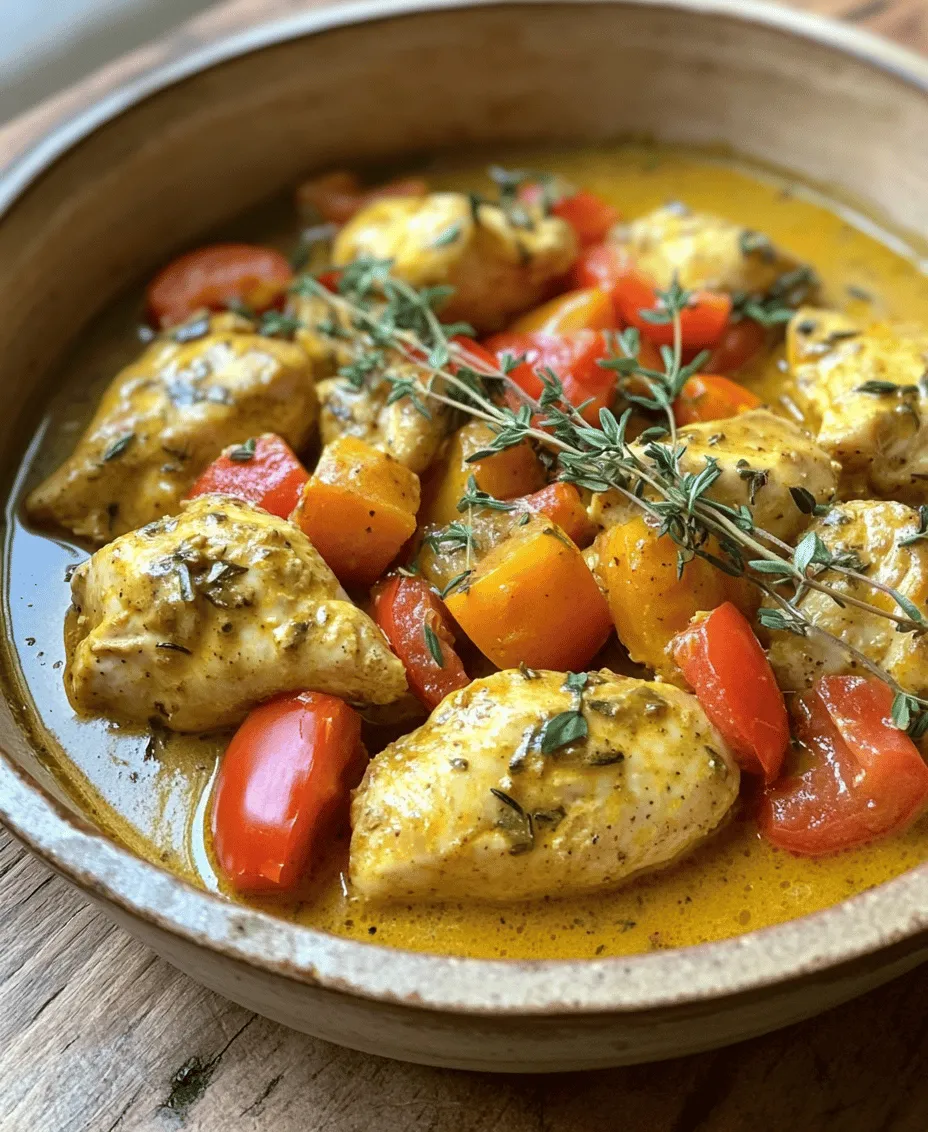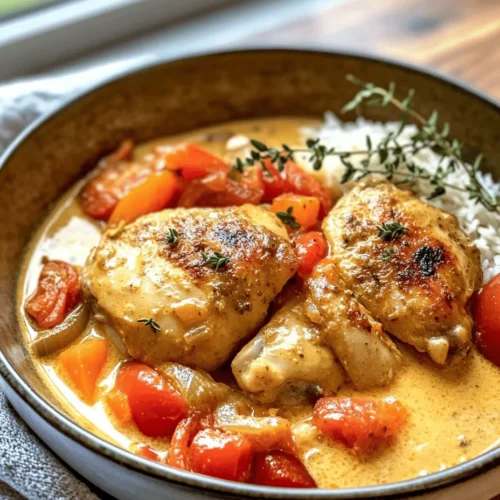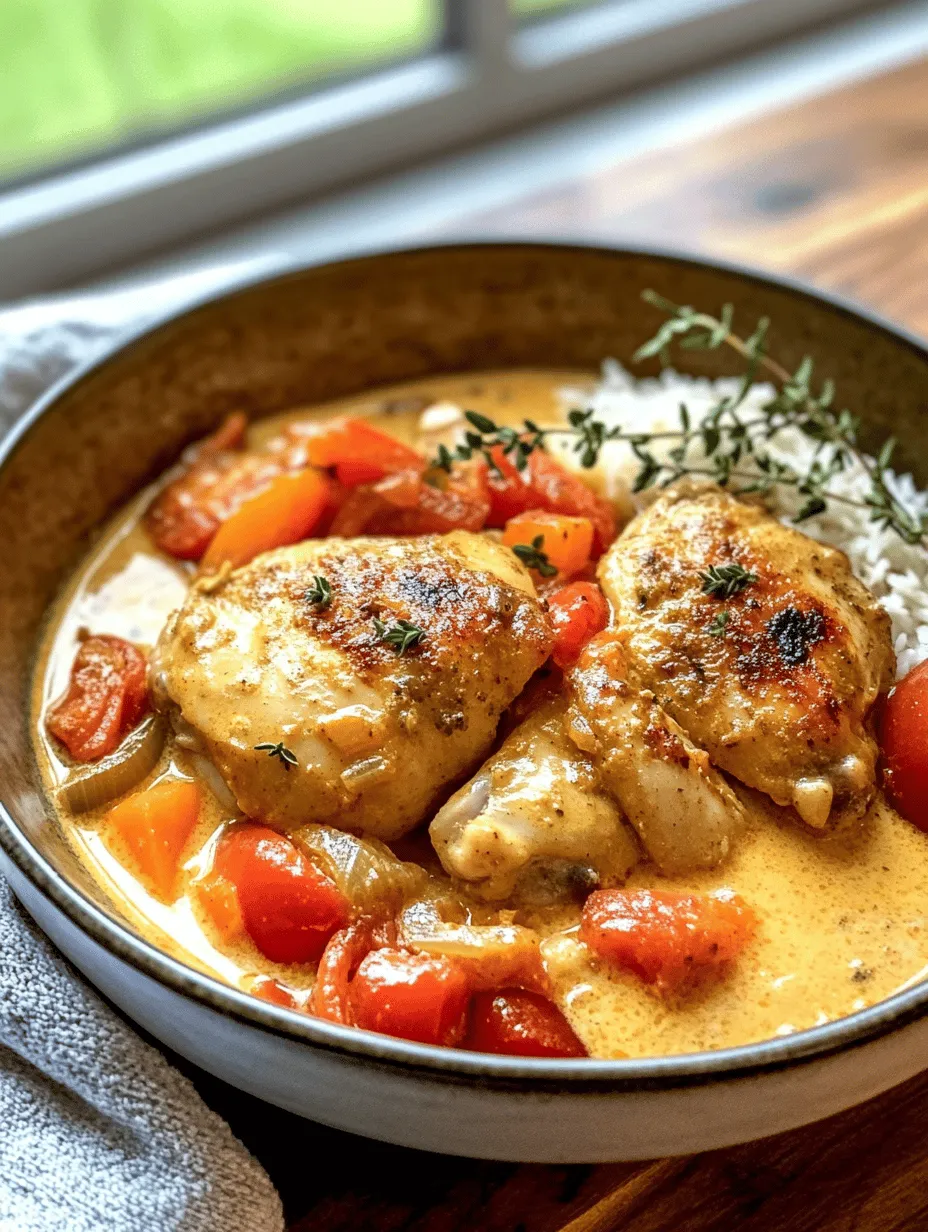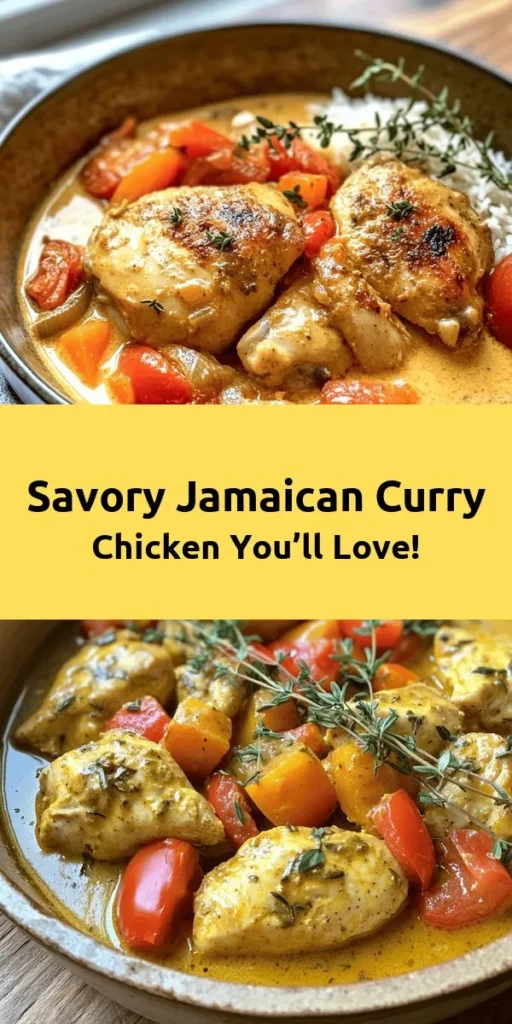Introduction
Jamaican cuisine is a vibrant tapestry of flavors, colors, and aromas that reflect the island’s rich cultural heritage. From the boldness of jerk seasoning to the comforting warmth of stews, Jamaican food offers a delightful culinary experience. One dish that stands out in this array of flavors is Authentic Jamaican Curry Chicken. This dish embodies the essence of Jamaican cooking—where spices and fresh ingredients come together to create a symphony of taste that is both comforting and exciting.
Curry holds a significant place in Jamaican cuisine, having been introduced by Indian indentured laborers in the 19th century. Over the years, it has evolved into a unique blend that reflects the local palate and available ingredients. Authentic Jamaican Curry Chicken is not just a meal; it is a celebration of the island’s history and cultural influences.
What makes this recipe truly appealing is its simplicity and depth of flavor. With just a handful of ingredients and straightforward preparation steps, you can create a dish that is both satisfying and rich in culinary significance. Whether you’re serving it for a family dinner or a festive gathering, this dish is sure to impress and bring a taste of Jamaica to your table.
Understanding Jamaican Curry
To appreciate Authentic Jamaican Curry Chicken fully, it is essential to understand the history and origins of curry within Jamaican cuisine. The introduction of curry to Jamaica can be traced back to the arrival of Indian laborers who brought their culinary traditions to the island. Over time, these flavors melded with local ingredients and cooking methods, creating a distinct style of curry that is unique to Jamaica.
In Jamaican cooking, spices are the heart and soul of the dishes. The use of aromatic spices not only adds flavor but also enhances the overall dining experience. Jamaican curry is characterized by its robust and fragrant spices, which often include turmeric, cumin, coriander, and fenugreek. However, the star of the show is Jamaican curry powder, a special blend that sets it apart from other styles of curry.
When comparing Jamaican curry to other curry styles, such as Indian or Thai, there are notable differences. Jamaican curry tends to be less complex in terms of flavor layering but compensates with its boldness. The use of allspice (pimento) is a defining feature in Jamaican curry, providing a warm, sweet, and slightly peppery flavor that is hard to find in other curries. This unique spice, along with the addition of fresh herbs and locally grown peppers, creates a flavor profile that is distinctly Jamaican.
Key ingredients that define Jamaican curry include Jamaican curry powder, allspice, scallions, Scotch bonnet peppers, and coconut milk. Each of these components plays a crucial role in building the dish’s flavor and texture, resulting in a curry that is both satisfying and memorable.
Ingredients Breakdown
When preparing Authentic Jamaican Curry Chicken, having the right ingredients is essential for achieving the authentic flavor profile. Below is a breakdown of the essential ingredients you will need, along with a detailed description of their roles in the dish.
Chicken
The choice of chicken is critical in this recipe. For the best flavor and texture, it is recommended to use bone-in, skin-on chicken pieces. The bones add depth to the dish as they release flavor during cooking, while the skin helps to retain moisture, resulting in tender and juicy meat. Common choices include thighs and drumsticks, which are flavorful and hold up well during the cooking process.
Jamaican Curry Powder
One of the most important ingredients in this recipe is Jamaican curry powder. Unlike its Indian counterpart, Jamaican curry powder typically has a more robust and earthy flavor, often with a hint of sweetness. It is usually a blend of turmeric, coriander, cumin, and other spices. The specific blend can vary from brand to brand, so it’s worth trying a few different types to find the one that best suits your taste. Authentic Jamaican curry powder can typically be found in Caribbean grocery stores or specialty spice shops.
Allspice
Allspice, also known as pimento, is a quintessential ingredient in Jamaican cooking. It offers a unique flavor profile reminiscent of cinnamon, nutmeg, and cloves, all in one berry. In Authentic Jamaican Curry Chicken, allspice adds warmth and complexity, enhancing the overall richness of the dish. Whole berries can be used for a more intense flavor, or ground allspice can be incorporated into the curry for convenience.
Scallions and Scotch Bonnet Peppers
Scallions, or green onions, are often used in Jamaican cooking to add a fresh, mild onion flavor that complements the spices. They are usually sliced and added during the cooking process to infuse their flavor into the dish. On the other hand, Scotch bonnet peppers are a staple in Jamaican cuisine, known for their fiery heat. While they add a significant amount of spice, their flavor is also fruity and aromatic, which enhances the overall taste of the curry. If you prefer a milder dish, you can adjust the number of peppers used or remove the seeds before adding them to the pot.
Coconut Milk
Coconut milk is another essential ingredient that adds creaminess and richness to the curry. It balances the heat from the Scotch bonnet peppers and provides a luxurious texture to the dish. Using full-fat coconut milk will yield the best results, giving the curry a rich and velvety consistency. If you are looking for a lighter version, you can opt for light coconut milk, but be mindful that it may alter the final flavor and texture.
Optional Ingredients
While the above ingredients are the backbone of Authentic Jamaican Curry Chicken, there are several optional ingredients that can enhance the dish further. For example, adding carrots or potatoes can provide additional texture and natural sweetness. Fresh thyme is another herb commonly used in Jamaican cooking, adding an aromatic quality that complements the spices. Additionally, a splash of lime juice before serving can brighten the flavors and add a refreshing contrast to the richness of the curry.
Preparation Steps in Detail
Now that you have gathered all the necessary ingredients, it’s time to dive into the preparation of Authentic Jamaican Curry Chicken. Follow these detailed steps to ensure that your dish turns out perfectly, full of flavor and authenticity.
1. Marinate the Chicken: Begin by cleaning the chicken pieces thoroughly. Pat them dry with paper towels and place them in a large bowl. Season the chicken generously with salt, black pepper, and a few tablespoons of Jamaican curry powder. Use your hands to massage the spices into the meat, ensuring that each piece is well-coated. For optimal flavor, allow the chicken to marinate for at least 1 hour, or overnight in the refrigerator if time permits.
2. Prepare the Vegetables: While the chicken is marinating, prepare the vegetables. Chop the scallions, and slice the Scotch bonnet peppers (removing the seeds if you desire less heat). Set these aside for later use. If you are including optional vegetables like carrots or potatoes, chop them into bite-sized pieces.
3. Heat the Oil: In a large, heavy-bottomed pot or Dutch oven, heat a few tablespoons of vegetable oil over medium heat. The oil should be hot but not smoking. This step is crucial as it helps to develop the flavors of the spices.
4. Sauté the Aromatics: Once the oil is hot, add the chopped scallions and sliced Scotch bonnet peppers to the pot. Sauté them for about 2-3 minutes until they become fragrant and softened. Be mindful not to burn them, as this can lead to a bitter taste.
5. Add the Chicken: Next, add the marinated chicken pieces to the pot, skin side down. Allow the chicken to sear for about 5 minutes without moving it, which will help to develop a nice golden-brown color. After 5 minutes, flip the chicken pieces to sear the other side for an additional 5 minutes.
6. Incorporate the Spices: Once the chicken is nicely browned, sprinkle in the remaining curry powder and allspice. Stir the spices into the chicken, ensuring that every piece is coated. This step is vital for building the flavor profile of the curry.
7. Add Coconut Milk and Simmer: Pour in the coconut milk, scraping the bottom of the pot to release any browned bits—this adds depth to your curry. Bring the mixture to a gentle simmer, then reduce the heat to low. Cover the pot and let the curry simmer for about 30-40 minutes, allowing the chicken to cook through and the flavors to meld beautifully.
8. Check for Doneness: After the simmering time, check the chicken for doneness. It should be tender and fully cooked, reaching an internal temperature of 165°F (75°C). If using optional vegetables, add them during the last 10-15 minutes of cooking, allowing them to become tender but not mushy.
9. Final Touches: Taste the curry and adjust the seasoning as needed. If you prefer a thicker sauce, uncover the pot and let it simmer for a few more minutes until the desired consistency is achieved. For added brightness, consider squeezing in a bit of fresh lime juice before serving.
By following these steps, you will create a delicious and authentic Jamaican Curry Chicken that not only satisfies your taste buds but also pays homage to the rich culinary heritage of Jamaica. As you prepare this dish, the enticing aromas will fill your kitchen, transporting you to the vibrant streets of Jamaica with every bite.

Detailed Marination Process
Marinating chicken is a crucial step in achieving the authentic flavors of Jamaican Curry Chicken. The marination process allows the spices to penetrate the meat, enhancing its flavor profile and tenderness. For this recipe, it is recommended to marinate the chicken for at least 4 hours, but if time permits, an overnight marination will yield even better results. This extended duration allows the chicken to absorb the rich spices and develop a deeper flavor, which is characteristic of Jamaican cuisine.
To marinate the chicken, combine the chicken pieces with curry powder, allspice, thyme, garlic, ginger, and a bit of salt in a large bowl. Mix well to ensure each piece is coated evenly. Cover the bowl with plastic wrap or transfer the mixture into a resealable plastic bag and place it in the refrigerator. The acidic components in the marinade, such as lime juice or vinegar, also aid in tenderizing the meat, making it more succulent.
Techniques for Sautéing Onions, Garlic, and Ginger for Maximum Flavor
Sautéing the aromatics is an essential step that builds the foundation of flavors in your curry chicken. Start by heating a generous amount of oil—preferably vegetable or coconut oil—in a large pot over medium heat.
1. Onions: Add chopped onions first and sauté them until they become translucent and slightly caramelized. This process usually takes about 5-7 minutes. The sweetness from the onions will balance the spices.
2. Garlic and Ginger: Once the onions are ready, add minced garlic and grated ginger. Stir them in and sauté for an additional 1-2 minutes until fragrant. Be careful not to burn the garlic, as it can turn bitter.
This method of sautéing will maximize the flavor released from the onions, garlic, and ginger, setting a delicious base for your curry chicken.
Best Practices for Adding and Cooking Vegetables
When it comes to adding vegetables to your curry, the goal is to retain their texture and flavor. Start by selecting vegetables that complement the dish, such as bell peppers, carrots, and potatoes.
1. Timing: Add harder vegetables, such as carrots and potatoes, early in the cooking process to give them enough time to soften. Softer vegetables, like bell peppers, can be added later to maintain their crunch.
2. Cut Size: Ensure that the vegetables are cut into uniform pieces. This ensures even cooking and prevents some pieces from becoming mushy while others remain undercooked.
3. Gentle Cooking: Stir the vegetables gently to incorporate them into the curry without breaking them down entirely. This technique preserves their texture and adds a delightful contrast to the tender chicken.
Tips for Browning Chicken: Achieving the Perfect Sear
To achieve that rich, deep flavor in your Jamaican Curry Chicken, it’s essential to brown the chicken properly. This process caramelizes the surface of the chicken, creating a rich crust that enhances the dish’s overall taste.
– Single Layer Cooking: When adding chicken to the pot, do so in a single layer without overcrowding. This allows the chicken to sear rather than steam. You may need to brown the chicken in batches.
– Don’t Rush: Allow the chicken to cook undisturbed for a few minutes before flipping. This patience will yield a golden brown crust, which is crucial for flavor development.
– Temperature Control: Ensure your pot is hot enough before adding the chicken, but not so hot that the oil smokes. A medium-high heat is ideal for browning.
Explanation of Simmering: Time and Temperature for Optimal Tenderness
Simmering is the next key step in cooking your Jamaican Curry Chicken. After browning the chicken, it’s essential to simmer it to allow the flavors to meld and the chicken to become tender.
– Simmering Temperature: Once you add your liquid (coconut milk, broth, or water), bring it to a gentle boil and then reduce the heat to low to maintain a simmer. The ideal temperature for simmering is around 180°F (82°C).
– Timing: Allow the curry to simmer for at least 30 to 40 minutes, stirring occasionally. This duration allows the chicken to absorb the spices fully and become tender without drying out.
Cooking the Authentic Jamaican Curry Chicken
Step-by-Step Guide to Combining Ingredients in the Pot
1. Heat the Oil: In a large pot, heat 2-3 tablespoons of vegetable oil over medium heat.
2. Sauté the Aromatics: Add chopped onions, stirring until translucent. Follow with minced garlic and grated ginger, cooking until fragrant.
3. Brown the Chicken: Add marinated chicken to the pot in batches, allowing it to brown on all sides.
4. Combine Spices and Vegetables: Once all the chicken is browned, return it to the pot. Add diced potatoes and carrots, followed by any remaining spices, such as additional curry powder and allspice.
5. Add Liquid: Pour in coconut milk and a bit of chicken broth (or water) until the chicken is just covered.
6. Simmer: Bring the mixture to a boil, then reduce the heat to low, cover, and let it simmer for 30-40 minutes or until the chicken is tender and fully cooked.
The Importance of Adjusting Seasoning at Different Stages of Cooking
Taste your curry at various stages of cooking. After simmering, you may find that the flavors have melded beautifully, but a pinch of salt or a dash of black pepper might enhance the dish even further. Adjusting seasoning throughout the cooking process ensures a balanced flavor profile.
Visual Cues for Knowing When the Curry is Ready
The curry is ready when the chicken pieces are tender and easily pull apart with a fork. Additionally, the sauce should be thick and flavorful, clinging beautifully to the chicken. A vibrant color, indicative of the spices, will also signal that your dish is approaching perfection.
Suggestions for Serving Accompaniments that Enhance the Meal
Authentic Jamaican Curry Chicken is best enjoyed with traditional accompaniments that enhance the overall experience. Here are some serving suggestions:
– Rice and Peas: This classic dish made from rice, kidney beans (or pigeon peas), and coconut milk complements the curry beautifully.
– Fried Plantains: The sweetness of fried plantains balances the spices in the curry, providing a delightful contrast.
– Coleslaw: A refreshing side of coleslaw adds crunch and a tangy flavor that contrasts the richness of the curry.
– Roti or Dumplings: These are excellent for scooping up the delicious sauce.
Cultural Significance of Curry Chicken in Jamaica
Curry chicken holds a special place in the culinary landscape of Jamaica. It is a dish often prepared for family gatherings, celebrations, and Sunday dinners—symbolizing togetherness and community.
Role of Curry Chicken in Jamaican Households and Celebrations
In Jamaican households, curry chicken is more than just a meal; it signifies hospitality and cultural heritage. It is commonly served during festive occasions such as weddings, holidays, and family reunions, where it brings people together to share in the joy of food and fellowship.
Variations of Curry Chicken Across Different Jamaican Regions
Different regions in Jamaica have their own unique takes on curry chicken. For example, in the coastal areas, you might find variations that incorporate seafood, while inland recipes may emphasize heartier vegetables and spices. Each variation showcases the diversity and richness of Jamaican cuisine.
Personal Stories or Anecdotes Related to Curry Chicken in Jamaican Culture
Many Jamaicans have fond memories associated with curry chicken, often recalling family gatherings where the dish was the centerpiece. Stories of elders teaching younger generations how to prepare this beloved recipe are common, passing down not just cooking techniques but also cultural traditions.
Nutritional Information
When prepared thoughtfully, Jamaican Curry Chicken can be a nutritious meal. Here’s a breakdown of the nutritional content of a typical serving:
– Calories: Approximately 400-500 calories per serving, depending on the amount of coconut milk used.
– Protein: Rich in protein due to the chicken, providing roughly 30-35 grams per serving.
– Healthy Fats: The use of coconut milk adds healthy fats, particularly medium-chain triglycerides (MCTs), which can provide quick energy.
Discussion on the Health Benefits of Curry Spices and Coconut Milk
Curry spices are known for their numerous health benefits, including anti-inflammatory properties, aiding digestion, and boosting immunity. Turmeric, a key ingredient in curry powder, is particularly renowned for its health benefits. Coconut milk also offers health benefits, such as healthy fats that support heart health and provide essential nutrients.
Tips on Balancing Traditional Recipes with Healthy Eating Habits
To make this recipe healthier, consider using skinless chicken breast instead of thighs, reducing the amount of coconut milk, or incorporating more vegetables into the dish. Additionally, serving the curry with brown rice instead of white rice can enhance the fiber content of the meal.
Conclusion
Authentic Jamaican Curry Chicken is a delightful dish that encapsulates the rich flavors and cultural heritage of Jamaica. Its blend of spices, tender chicken, and vibrant vegetables creates a meal that is not only satisfying but also deeply rooted in tradition.
As you experiment with this recipe, you will not only enjoy a delicious dish but also gain a deeper appreciation for Jamaican cuisine. We encourage you to try this recipe, share your experiences, and explore the diverse world of Jamaican cooking. Feel free to share your variations or any personal anecdotes related to curry chicken in the comments section; we would love to hear from you!



